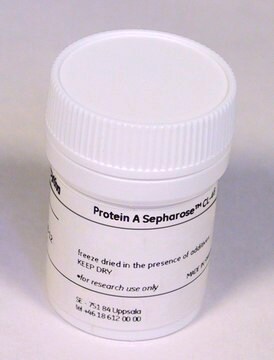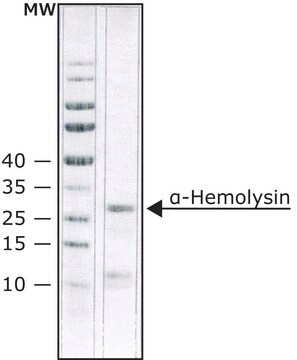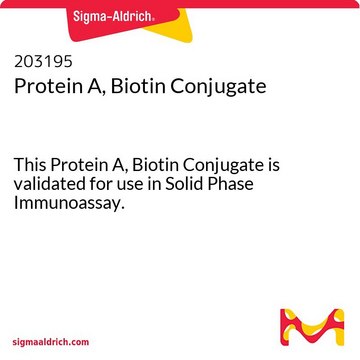P6031
Protein A from Staphylococcus aureus
Soluble, essentially salt-free, lyophilized powder, extracellular
Sinónimos:
Protein A resin
About This Item
Productos recomendados
origen biológico
Staphylococcus aureus
Nivel de calidad
conjugado
unconjugated
formulario
essentially salt-free, lyophilized powder
capacidad
7-14 mg/mg, solid binding capacity (human IgG)
solubilidad
H2O: soluble 1 mg/mL, clear, colorless
Nº de acceso UniProt
temp. de almacenamiento
2-8°C
Información sobre el gen
Staphylococcus aureus subsp. aureus NCTC 8325 ... SAOUHSC_00069(3919448)
¿Está buscando productos similares? Visita Guía de comparación de productos
Descripción general
Aplicación
- to coat nitrocellulose sheet with protein A for immunoassay of agalactosyl IgG.
- as a blocking agent before the use of secondary antibody in immunohistochemistry.
- as a binding agent to antibody during antibody immobilization.
Acciones bioquímicas o fisiológicas
Protein A also participates in a number of different protective biological functions including anti-tumor, toxic, and carcinogenic activities. In addition to acting as an immunomodulator, it also has antifungal and antiparasitic properties.
Nota de preparación
Cláusula de descargo de responsabilidad
Código de clase de almacenamiento
11 - Combustible Solids
Clase de riesgo para el agua (WGK)
WGK 3
Punto de inflamabilidad (°F)
Not applicable
Punto de inflamabilidad (°C)
Not applicable
Equipo de protección personal
Eyeshields, Gloves, type N95 (US)
Certificados de análisis (COA)
Busque Certificados de análisis (COA) introduciendo el número de lote del producto. Los números de lote se encuentran en la etiqueta del producto después de las palabras «Lot» o «Batch»
¿Ya tiene este producto?
Encuentre la documentación para los productos que ha comprado recientemente en la Biblioteca de documentos.
Los clientes también vieron
Nuestro equipo de científicos tiene experiencia en todas las áreas de investigación: Ciencias de la vida, Ciencia de los materiales, Síntesis química, Cromatografía, Analítica y muchas otras.
Póngase en contacto con el Servicio técnico










